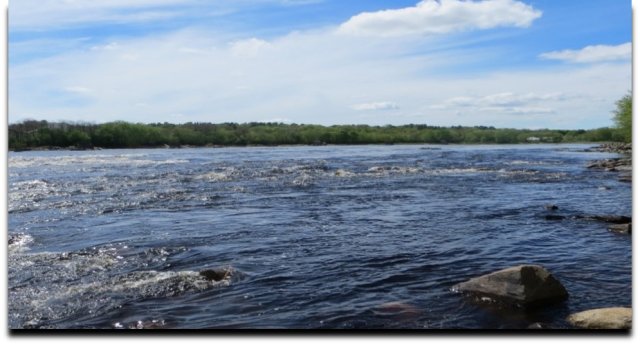One Health Assessment: Fish Returning to the Penobscot River
Published November 29, 2022

After nearly two hundred years, striped bass, American shad, rainbow smelt, river herring and other fish species have finally returned to Maine’s Penobscot River. In 2004, a collaborative trust formed by Tribal, state, non-governmental organizations and federal partners began an effort to restore fisheries in the river by removing some of the dams that blocked the passage of migratory fish species. The Great Works and Veazie Dams had blocked the river for nearly 200 years before their removal in 2012 and 2013, allowing fish to finally return after centuries. Migratory fish, such as bass, shad, and smelt, that spend most of their lives in saltwater but spawn in freshwater, are known as anadromous fish. Dam removals, along with other river restoration practices, have allowed anadromous fish species to return to Penobscot Reservation waters, home of the Penobscot Indian Nation (“Nation”). However, with the return of the fish came the concern of whether they carry contaminants that may pose various health concerns to tribal members and wildlife.
The Penobscot River is of great importance to members of the Nation, whose culture, livelihood, and traditional ecological knowledge are linked to the Penobscot River watershed, as are their traditional practices such as fishing, hunting, and gathering plants for food and medicine. Over the years, the Nation’s ability to continue its traditional practices and exercise its fishing rights has been greatly diminished by the presence of hydroelectric dams and contaminants in local fish species. The removal of these dams and the return of anadromous fish has been of particular importance to the Nation, but there are concerns that the fish may carry harmful contaminants, such as mercury, that can pose a health hazard to Nation members who consume them regularly.
The Agency for Toxic Substances and Disease Registry (ATSDR) issued recommendations to limit consumption of resident fish (i.e., fish that are not anadromous) from Penobscot waters because of elevated contaminant levels of inorganic and organic compounds. However, at the time, contaminant levels of anadromous species had yet to be researched.
EPA researchers collaborated with the ATSDR and the Nation to gain a better understanding of the contaminant levels in anadromous fish. Anadromous fish species do not feed during spawning, which causes their bodily contaminant levels to differ from local fish species. The research team collected American shad, striped bass, alewife, rainbow smelt, blueback herring, and sea lamprey at the Milford Dam fish lift and at downstream locations along the Penobscot River. The team analyzed the fish samples for multiple contaminants, including mercury, dioxin, furan, polybrominated diphenyl ethers (PBDEs), polychlorinated biphenyls (PCBs), and per- and polyfluoroalkyl substances (PFAS). Researchers found that the shad, rainbow smelt, striped bass, and sea lamprey samples contained levels of mercury that could pose a health concern for young children and pregnant women and could interfere with a child’s cognitive development. Rainbow smelt and striped bass from the Penobscot River could also pose a risk to nervous system health in children and adults who consume them daily. The dioxin, furan, and PCB levels found in the majority of samples pose potential health risks to children and adults, including immune system effects. ATSDR also concluded that levels of PFAS in sea lamprey, striped bass, blueback herring, and shad roe might lead to adverse health effects. Researchers further concluded that Nation members should not eat any of the anadromous fish sampled in this research due to the high levels of different contaminants that may cause harmful effects, including a significantly increased risk for liver cancer.
Fish from the Penobscot River are also consumed by wildlife. The research team implemented a One Health Approach, which not only takes human risk into account, but also considers the interconnectedness with wildlife and environmental health. Several species depend on the Penobscot River for survival. Researchers calculated the impact of the contaminants on wildlife by converting the fish fillet samples to whole fish concentrations and comparing them to wildlife values. The mercury, PCBs, and PFAS levels found in rainbow smelt, striped bass, and sea lamprey put animals who consume them at risk, including mink, otters, and eagles.
Fish advisories aim to reduce the exposure risk of Nation members and also provide information used to assess the sustainability of a traditional Penobscot diet. Acknowledging the impacts of the contaminants studied on wildlife is extremely important in understanding the health of the ecological system. Due to the dioxin levels detected in the fish, the research team recommended that Nation members should not consume any of the anadromous fish described in the assessment. The ATSDR provided the Penobscot Indian Tribal Council with a health consultation containing these recommendations, as well as the complete results of the research. The results of this study are being used by the Nation to update their Wild Foods brochure, fish consumption advisories, their E-newsletter, and website. The findings will also inform the review and/or development of water quality standards that will help protect tribal practices.
EPA Region 1 scientists are conducting ongoing research involving Tribal groups, such as the Nation, to understand their exposure to PCBs in waterbodies. Another project is utilizing eDNA technology to enhance surveillance of tribal aquatic resources in both marine and fresh water.
“Research to determine contaminant levels in fish is a critical effort for the Penobscot Nation, as with other Wabanaki Tribes. Many of our tribal members continue to practice a sustenance lifestyle which includes consumption of fish from our reservation waters. The Penobscot Nation is grateful for the work undertaken by this dedicated team of professionals to help the tribe better understand contaminant levels in our migratory fish populations,” said John S. Banks, Director of Department of Natural Resources Penobscot Nation.
